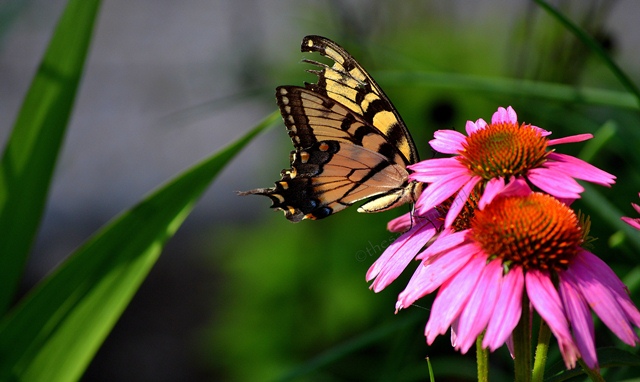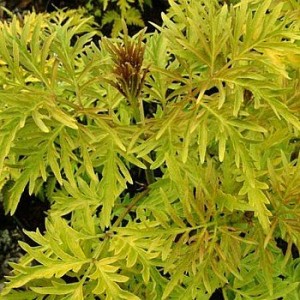Planting for Butterflies
Is our garden something we really own or a piece of this earth which has been entrusted to us? Are we caretakers rather than landowners who by association have the responsibility – and honor – of nurturing all that grows in and on it?
I’m no philosopher and this is not intended to be a post about environmental awareness although that is something which I personally take very seriously. I simply want to remind us all not to take our gardens, fragile ecosystems and their natural beauty for granted.
I watched a film while I was in England recently which discussed the decline of the British hedgerows and the negative impact that had on agriculture as habitat for beneficial insects had been removed. Mass crop spraying then became common which only exacerbated the situation by killing off not only the ‘bad bugs’ but also the dwindling bee population together with other beneficials who given time could have preyed on the insects causing crop damage. All in the effort to make fields larger so the big machinery could harvest more efficiently. How often do our ‘good ideas’ turn out to be not quite so good after all?
I hope I never become complacent about butterflies. They bring magic and movement to the summer garden as nothing else can, flitting daintily from one flower to another as though dancing on tip toes. From the tiny spring azure with its periwinkle wings to the dramatic yellow and black Western swallowtail, I love them all. How can we not be in awe of such beauty?
Yet there are far fewer butterflies today than there used to be as a result of pesticide misuse and removal of natural habitat for both larvae and adults. By simply planting a few flowering trees, shrubs and perennials to provide food for these creatures we can do our own small part to redress the balance and be rewarded tenfold by their presence.
Butterfly bush (Buddleia sp.) is considered the caviar on the butterfly buffet table and is a favorite of the swallowtail butterflies. I particularly like ‘Lochinch’ with its clusters of fragrant, lavender flowers each dotted with an orange eye on a beautiful felted silvery bush 8-10’ tall and wide. I grew mine in a container before transplanting it to the garden where it can now stretch out. Since hummingbirds also love it I have planted a mass of the scarlet Crocosmia ‘Lucifer’ to one side to provide a veritable feast for these visitors. Now I just need a comfy bench (and my camera) to enjoy the show!
‘Ice chip’ is a new, compact variety which at 2’ tall can even be grown as a groundcover. Although covered in short white floral spikes all summer this variety has proven sterile – good news for those who live in areas where the species Buddleia davidii is on the noxious weed list.
‘Miss Molly’ takes the color spectrum to new heights with its vibrant magenta blooms creating a 5’ siren for all butterflies and hummingbirds. Other sterile varieties include ‘Asian moon’, the ‘Flutterby’ series (Ball Horticultural), ‘Lo and behold’ (Proven Winners).
Elderberries (Sambucus sp) grow wild in many areas of North America and England. I recall gathering the berries with my Granddad as a child which he then sold at the local greengrocer’s. I don’t think I was ever told, however, that they were being sold to make wine! The clusters of flowers are a valuable food source for butterflies and other wildlife in the forest but there are some truly outstanding ornamental cultivars which deserve a place in our gardens. ‘Sutherland gold’ is one which will light up the border in sun or part shade. Conical clusters of creamy yellow flowers in mid spring are followed by glossy, bright red fruits while deeply cut, bronze juvenile leaves turn a bright golden yellow as the season progresses.
Two darker leaved varieties are ‘Black beauty’ and ‘Black lace’, the latter having more finely dissected foliage but both equally dramatic. The sprays of fragrant, frothy pink flowers draw butterflies and bees like magnets. The really good news is that the deer don’t like them! How many more excuses do you need to pick one up from the nursery? Elderberries can be left to grow into large shrubs or cut down (coppiced) to keep smaller as desired.
Coneflowers (Echinacea) bloom in mid-late summer and are a favorite of the red admiral butterflies. These old fashioned perennials are easy to grow, drought tolerant and deer resistant. They provide cut flowers for the home, nectar for the butterflies and seed heads or the birds. That’s great value from one $5 plant. In shades from pastels to flashy neon you’ll certainly find one to suit your color scheme.
Depending upon where you live, Lantana may be available for the garden as a hardy bush or a summer annual. In appearance they resemble Verbena (they belong to the same Family) with numerous heads of clustered, vividly colored flowers. I use them a lot in hanging baskets and especially like the variety ‘Dallas Red’ which has bi-colored blooms in red and yellow. Lantana thrive in hot, arid conditions.
It may be stating the obvious, but if you want butterflies you have to accept the presence of a few caterpillars. That in turn may mean lowering your housekeeping standards and accepting a few nibbled leaves. For the life cycle to be complete these beautiful butterflies need to lay eggs on a host plant which will then provide food for the larvae. Not just any old leaf will do, however, as butterfly larvae are very host specific. For example the larvae of the Western tiger swallowtail prefer big-leaf maple, willow, poplar and cottonwood while painted lady butterflies prefer thistle but will also eat nettles, hollyhock and sunflowers.
Our 5 acre garden transitions into meadow and forest on the perimeters. There are large stands of native Pacific willow, alders and cottonwoods all of which support the lifecycle of various butterflies. We are fortunate to have such a large butterfly larvae pantry but it is also a reminder that we all need a little ‘wild side’ in our garden to enjoy its true potential.
We have been given a precious gift, whether our garden is an expansive acreage or a modest patio container. That gift affords us an opportunity to enjoy Nature up close with all its rich scents and vibrant colors and to encourage the fleeting beauty of butterflies by simply including a special plant or two.
Recommended books;
Landscaping for Wildlife in the Pacific Northwest by Russell Link 1999 (University of Washington Press) – an excellent book with information on natural habitat maintenance and enhancement as well as ideas for encouraging wildlife into the garden. I find myself referring to this often.
Useful links with extensive plant lists
http://butterflywebsite.com/butterflygardening.cfm
http://www.almanac.com/content/plants-attract-butterflies
http://www.gardenswithwings.com/what-is-a-butterfly-garden/host-plants.html







These are great tips, Karen. I have several of the butterfly bush, coneflower, and lantana. I will have to try the elderberry…anything to have more butterflies! I have some blooms in the garden at the moment, but not enough to keep the butterflies hovering around. They seem to fly through so quickly. I look forward to the next few months when they will begin to find more in my garden. Thanks for the photo credit.
Michelle, thank you SO much for allowing me to use your images, Your photography is truly outstanding and I know all my readers will find it inspiring.
I have realized that I need a succession of blooms for the waves of different species of butterflies throughout the season. I do fine for mid-late summer but I don't seem to have anything for the earlier butterflies like the azures. I must try to find something!
Great post! Butterflies are a joy, and I have added some of your suggestions to my own garden. I noticed today that my butterfly bush is full of buds. Hopefully we will soon have lots of blooms and butterflies!
I'm already seeing some of the early butterflies Deb. Now I just need the plants to catch up!
I'm beginning to see more butterflies in my neighborhood, now that some of the landscaping in the area is starting to mature. What a difference they make to the sense of life in a garden! You're too right, though, about needing to understand that caterpillars come first. I have some rue growing, which a favorite gardening book says "is a host plant for larvae of the swallowtail butterfly," but didn't quite translate that right in my head until I saw very chubby caterpillars devouring it!
That paints a Disney-style picture Stacy!! Actually I'm sure I have a hidden corner somewhere for rue so I might add some as the western swallowtail seems to be our most common butterfly.
Hi Karen, I have stopped thinking of gardening as doing battle with mother nature and instead started thinking of gardening as a partnership instead. I agree that ever garden needs a "wild" side and that if you want butterflies, you need to tolerate that which comes first, caterpillars.
I like your idea of a 'partnership' – well said. We talk about achieving balance in our personal lives but we also need to aim for balance rather than outright control in our gardens if we are to nurture wildlife.